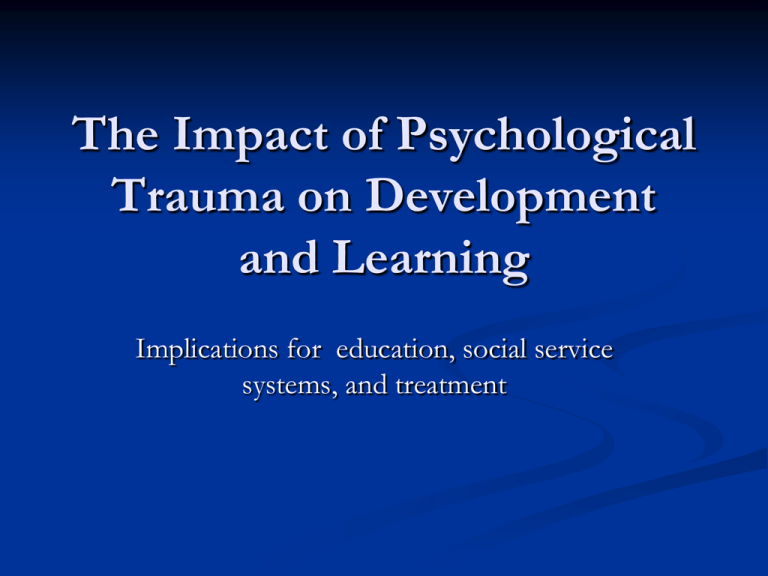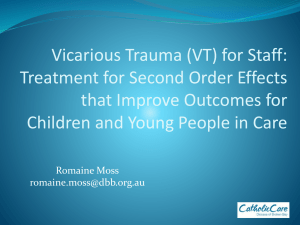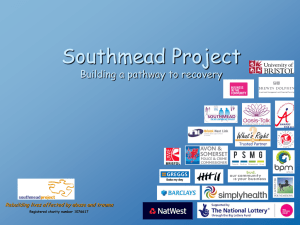
The Impact of Psychological
Trauma on Development
and Learning
Implications for education, social service
systems, and treatment
Definition of a traumatic event
A traumatic event is any event or
events, which overwhelms our core
capacity to cope.
It results in an experience of personal
threat to our safety and/or the integrity
of our identity.
Complex Trauma
Multiple and/or chronic exposure to
developmentally adverse interpersonal
victimization
physical, sexual and emotional abuse
and neglect
domestic and community violence
What Is Child Traumatic
Stress?
Child traumatic stress refers to the physical
and emotional responses of a child to events
that threaten the life or physical integrity of
the child or of someone critically important to
the child (such as a parent or sibling).
Traumatic events overwhelm a child’s
capacity to cope and elicit feelings of terror,
powerlessness, and out-of-control
physiological arousal.
Types of Traumatic Stress
Acute trauma is a single traumatic event that is
limited in time. Examples include:
Serious accidents
Community violence
Natural disasters (earthquakes, wildfires, floods)
Sudden or violent loss of a loved one
Physical or sexual assault (e.g., being shot or raped)
During an acute event, children go through a
variety of feelings, thoughts, and physical
reactions that are frightening in and of themselves
and contribute to a sense of being overwhelmed.
Types of Traumatic Stress
Chronic trauma refers to the experience of
multiple traumatic events.
These may be multiple and varied events—
such as a child who is exposed to domestic
violence, is involved in a serious car accident,
and then becomes a victim of community
violence—or longstanding trauma such as
physical abuse, neglect, or war.
The effects of chronic trauma are often
cumulative, as each event serves to remind the
child of prior trauma and reinforce its negative
impact.
Statistics on Impact of Trauma
•61% of men and 50% of women in the U.S. will
experience at least one traumatic event in a
lifetime.
•5% of men and 10% of woman in the general
population have PTSD
(Kessler, et. Al., 1995)
•30-70% of persons in outpatient treatment and
40-72% of those in inpatient treatment report
histories of trauma
(Newman et. al., 1998)
•75% of persons in substance abuse were victims of
physical or sexual violence (SAMHSA, 2000)
U.S. Prevalence
One in four children/adolescents experience
at least one potentially traumatic event before
the age of 16.1
In a 1995 study, 41% of middle school students
in urban school systems reported witnessing a
stabbing or shooting in the previous year.2
Four out of 10 U.S. children report witnessing
violence;
8% report a lifetime prevalence of sexual
assault, and 17% report having been physically
assaulted.3
1. Costello et al. (2002). J Traum Stress;5(2):99-112.
2. Schwab-Stone et al. (1995). J Am Acad Child Adolesc Psychiatry;34(10):1343-1352.
3. Kilpatrick et al. (2003). US Dept. Of Justice. http://www.ncjrs.gov/pdffiles1/nij/194972.pdf.
Vermont Children Affected by Trauma
DCF 2011:
DCF intakes w/ domestic violence identified
•
(Domestic Violence Fatality Review Commission Report, 2009)
1212
(VT Network Against Domestic and Sexual Violence, 2011)
Emergency Room Injury Child Victims
•
1892
Children served by Network Programs
•
15,500 calls
4908 investigations
1037 children in custody (DCF 2011 Annual Report)
15,012 (10% referred to CMH)
Percentage in DCF custody served by CMH
•
24% (February 6, 2004).Vermont Mental Health Performance Indicator Project. Young Trauma Victims served in Mental Health Programs.
Children with Disabilities
Incidence per 1,000
Children w/out
Disabilities
Children w/
Disabilities
Physical Abuse
Sexual Abuse
4.5
2.0
9.5
3.5
Emotional Abuse
2.9
3.5
(Goldson, 2002)
Neglect, physical abuse, and emotional abuse are most
often perpetrated by immediate family members.
Sexual abuse is largely perpetrated by extrafamilial
members
(Sullivan and Knutson, 2000).
Domestic and Sexual Violence in
Vermont
VT Network Against Domestic and Sexual
Violence:
•Served 1,025 victims of sexual assault
•7317 individuals who experienced domestic violence
•responded to 10,250 hotline crisis calls in FY 2011.
Domestic Violence and VT Crime
51% of all VT homicides involved domestic
violence from 1994-2010
95% of all violent crime in VT involved
intimate partners (VT Div of Crim Justice, 2007)
VT ranked sixth in the nation for per capita
murder of women by men in single incidents
w/ single victims
Prevalence of Child Abuse
Child Abuse World-Wide
■ 73 million boys
■ 150 million girls
Are Sexually abused annually
■ 53,000 children are murdered each year
World Health Organization
7 Domains of Impairment in Children
Exposed to Complex Trauma
1. ATTACHMENT:
Uncertainty about the reliability and predictability of the
world
Problems with boundaries
Distrust and suspiciousness
Social isolation
Interpersonal difficulties
Difficulty attuning to other people’s emotional states
Difficulty with perspective taking
Difficulty enlisting other people as allies
7 Domains of Impairment in Children
Exposed to Complex Trauma
2. BIOLOGY:
Sensorimotor developmental problems
Hypersensitivity to physical contact
Analgesia
Problems with coordination, balance, body tone
Difficulties localizing skin contact
Somatization
Increased medical problems across a wide span, e.g., pelvic
pain, asthma, skin problems, autoimmune disorders, pseudo
seizures
7 Domains of Impairment in Children
Exposed to Complex Trauma
3. AFFECT REGULATION:
Difficulty with emotional self-regulation
Difficulty describing feelings and internal experience
Problems knowing and describing internal states
Difficulty communicating wishes and desires
4. DISSOCIATION:
Distinct alterations in states of consciousness
Amnesia
Depersonalization and derealization
Two or more distinct states of consciousness, with impaired
memory for state-based events
7 Domains of Impairment in Children
Exposed to Complex Trauma
5. BEHAVIORAL CONTROL:
Poor modulation of impulses
Self-destructive behavior
Aggression against others
Pathological self-soothing behaviors
Sleep disturbances
Eating disorders
Substance abuse
Excessive compliance
Oppositional behavior
Difficulty understanding and complying with rules
Communication of traumatic past by reenactment in day-to-day
behavior or play (sexual, aggressive, etc.)
7 Domains of Impairment in Children
Exposed to Complex Trauma
6. COGNITION:
Difficulties in attention, regulation and executive functioning
Lack of sustained curiosity
Problems with processing novel information
Problems focusing on and completing tasks
Problems with object constancy
Difficulty planning and anticipating
Problems understanding own contribution to what happens to them
Learning difficulties
Problems with language development
Problems with orientation in time and space
Acoustic and visual perceptual problems
Impaired comprehension of complex visual-spatial patterns
7 Domains of Impairment in Children
Exposed to Complex Trauma
7. SELF-CONCEPT:
Lack of a continuous, predictable sense of self
Poor sense of separateness
Disturbances of body image
Low self-esteem
Shame and guilt
Impact of Childhood Trauma
Trauma effects every domain of functioning:
Developmental
milestones
Attachment
Intellectual
capacity
Cognitive ability
Affect regulation
Interpersonal functioning
Mental health
Immune/Autoimmune system
Impact of Child Abuse
Childhood trauma is associated with
increased rates of:
■ Imprisonment
■ Substance Abuse
■ HIV Status
■ Unemployment Status
■ Use of Psychiatric Services
■ Impaired Health Status
(Felitti, Anda, Nordenberg, Williamson, Spitz, Edwards, Koss & Marks, 1998).
Impact of Child Abuse
Children who have experienced a traumatic
event show an increased incidence of:
■
■
■
■
Ischemic heart disease
Cancer
Chronic Lung disease
Skeletal fractures
■ Liver disease
Impact of Child Abuse
■Temporal Lobe Epilepsy
■Developmental Disabilities; 10-25%
■3-6% of abused children will have a permanent
disability as a result of the abuse
■Between 20-50% of abused children suffer
mild to severe brain damage.
(Office of Trauma Services, Department of Mental Health, Mental Retardation and Substance Abuse Services,
Augusta, Maine)
Impact of Child Abuse
■
■
■
Early abuse and neglect negatively effect the
maturation of the developing brain.
80% of traumatized children have
disorganized attachment patterns
During adolescence traumatized children
have a 300% greater chance to engage in
substance abuse, self-mutilation and
aggressive behavior
The Neurobiology of Childhood Trauma and Abuse, Bessel van der Kolk, M.D.
A Biodevelopmental Framework
Early experiences leave a chemical “signature”
on our genes that determines whether and how
the genes are turned on or off.
This is known as “epigenetic adaptation,”
It shapes how our brains and bodies develop.
This is a biological mechanism
The environment of relationships, physical,
chemical, built environments, and early nutrition
cause the physiological adaptations and disruptions
that can influence a lifetime of well-being.
How Early Experiences Get into the Body: A
Biodevelopmental Framework
Traumatic Reaction
Exposure to Trauma
Reaction
Avoidance/Numbing
Re-Experiencing
Hyperarousal
Brain Lobes
Limbic System
Effects of Trauma on Brain
Function
Pre-frontal Cortex
(Integration and Planning)
olfactory
auditory
visual
kinesthetic
gustatory
Thalamus
Hippocampus
(cognitive map)
Amygdala
(significance)
Impact of Neglect on a Developing
Brain
Bruce Perry (2004). Maltreated Children: Experience, Brain Development, and the Next Generation
Long-Term Effects of Trauma
Generalized hyperarousal
•Problems with social attachment – excessive
dependence or isolation
•Aggression against self and others
•Inability to modulate sexual impulses
Alterations in Neurobiological processes in
stimulus discrimination
•Problems with attention and concentration
•Dissociation
•Somatization
Effects of Trauma
Conditioned fear responses to trauma-related
stimuli
Shattered meaning propositions
■ Loss of trust, hope, and sense of agency
■ Loss of “thoughts as experimental action”
Social avoidance
■ Loss of meaningful attachments
■ Lack of participation in preparing for the future
Developmental Stage: Birth-2
Normative:
Tasks: Identity, Connection,
Exploration, Agency
Communication through
physical activity
Strong increase in anxiety
when immediate needs not
met
Need physical human
contact for reassurance
Growth of sensory
perception/response
Trauma impact:
Altered connections; sacrifice
of exploration; deficits in
agency
Deficits in development of
non-verbal/ dyadic
communication strategies
Exposure to significant
arousal in absence of strategies
for soothing
Multiple potential “triggers”/
danger cues solidified on
NON-VERBAL level
Curriculum - Blaustein
Developmental Stage: 2-6
Normative:
Increased focus on
development of agency,
independence
Need for structure and
security
Cognitively aware of need for
nurturing
Minimal concept of
time/space
Speech available; but feelings
still communicated more
through play and behavior,
needs through words
Trauma Impact:
Continued sacrifice of
independence (or—ageinappropriate
independence)
Development of rigid
control strategies to manage
anxiety
Reliance on primitive
coping/self-soothing
Building of defenses against
affect and/or connection
Continued deficits in selfCurriculum - Blaustein
expression
Developmental Stage: Elementary
Normative:
Increase in independence and
industry
Increased ties to and
investment in school,
community, peers
Concrete information more
important than abstract in
meaning-making
Early understanding of
time/space, but still focused
on the present
Trauma Impact:
Reduced development of
competencies across
domains
School
deficits/impairments
Building and internalization
of negative self-concept/
self-blame
Failure to develop adequate
peer relationships;
vulnerability to harm by
others
Early onset depression/
hopelessness/ helplessness
Curriculum - Blaustein
Developmental Stage: Adolescence
Normative:
Striving for independence;
separation/individuation
Peer group important source
of support, information, and
reference
Self-conscious; belief in self
as focus of attention
Body image, sexual image,
self-image all important
Black-and-white view;
extremes, judgments
Able to see future but less
able to see consequences
Trauma Impact:
Premature separation or ageinappropriate dependence
Risk for negative peer
influence and affiliation
Significant risk for high-risk
behaviors
Over-control/perfectionism
Ongoing reliance on primitive
coping strategies, with failure
to develop age-appropriate
strategies
Crystallization of negative selfidentity
Curriculum - Blaustein
Developmental Stage: Adulthood
Normative:
Solidification of identity,
formation of adult
relationships, transition into
multiple roles, evaluation of
life industry
Able to function
independently, with others as
occasional source of
instrumental or emotional
support
Capacity to take perspective
Capacity to use abstract
thought
Able to link past, present, and
future
Trauma Impact:
Altered self-identity (selfblame, guilt, shame, damage,
powerlessness, etc.)
Impaired capacity to form
mature relationships (overdependence or under
dependence)
Difficulty regulating emotional
and physiological states, and
increasingly rigid reliance on
primitive strategies
Breakdown of cognitive
processes in face of danger/
overwhelming stress
Splintered identity and
Curriculum - Blaustein
functioning
Trauma Informed System
Trauma-informed services are not designed
to treat symptoms or syndromes related to
abuse or trauma. Instead, the primary
purpose is to deliver mental health,
addictions, housing supports, vocational or
employment counseling services, etc., in a
manner that acknowledges the role that
violence and victimization play in the lives
of most consumers of mental health and
substance abuse services.
Trauma Informed System
This understanding is used to design service
systems that accommodate the vulnerabilities of
trauma survivors and allow services to be delivered
in a way that will facilitate consumer participation
that is appropriate and helpful to the special needs
of trauma survivors.
Harris, M., & Fallot, R. EDS. (2001) Using trauma Theory to Design Service Systems, Jossey-Bass, San Francisco.
5 Principles of a TraumaInformed System
1.
2.
3.
4.
5.
Safety: Ensuring Physical & Emotional Safety
Trustworthiness: Maximizing trustworthiness
through Task, Clarity, Consistency, &
Interpersonal Boundaries
Choice: Maximizing Consumer Choice &
Control
Collaboration: Maximizing Collaboration and
Sharing Power
Empowerment: Prioritizing empowerment
and skill building
Fallot & Harris (2006)
•42
What Works
RICH
■ Respect
■ Information
■ Connection
■ Hope
■ Empowering and Collaborative Relationships
Risking Connection, Karen Saakvitne
What Works
Power
Choice
Control
Harris, M., & Fallot, R. EDS. (2001) Using trauma Theory to Design Service Systems, Jossey-Bass, San
Francisco.
C.L.E.A.R.E.D.
Create
Love
something (food, art, photography….)
your family, spouse, and pets and spend lots of
time with them
Exercise at least 3 times per week
Avoid excess in anything (food, caffeine, alcohol,
exercise, work…)
Relax with a good book, and schedule “nothing” time
Eat
healthy food
Dream about your goals and envision the future you
want for yourself and your family









